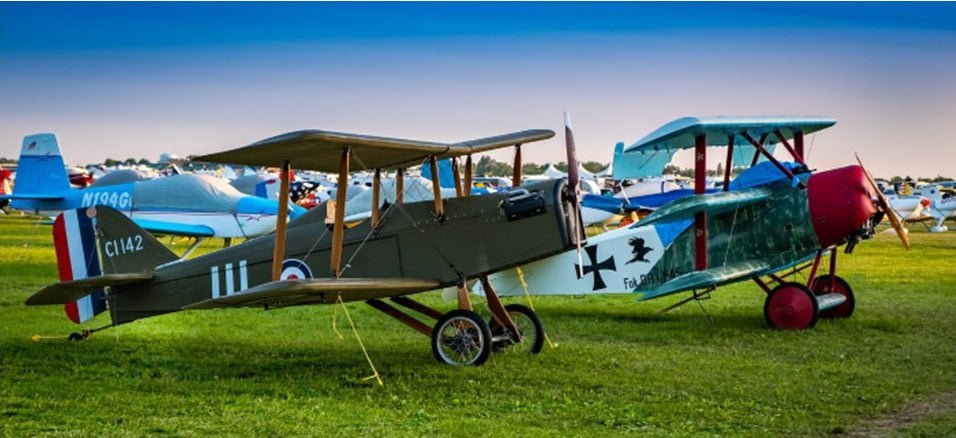
World War 1 happened just nine years after the Wright brothers flew the first powered aeroplane, however, the benefit of air power was quickly recognised by both armies. Initially as spotters, which, inevitably led to the other side sending up aeroplanes to stop them. The air war had begun!
Air Power of a tool of war
Inevitably, air power became a tool of war, which, as war always does, it sped up development, which eventually led to one of the greatest changes in society, a change at the beginning of the last century matching the growth of the internet at its end.
The problems of the first air war
To go back to the war, in the early days this development was not easy. Each side was looking for a way to use this very fragile invention to their advantage, with the result that on the British side alone about one in five of the 22,000 pilots who completed training died, to this must be added the thousand trainee pilots who died during their training. The development of the aeroplane was not easy.
The Germans used air balloons.
Meanwhile the Germans took a different tack developing their Zeppelins, air balloons to bomb British towns. They started on 19 January 1915, bombing Sheringham, Yarmouth, King’s Lynn along with other east coastal towns, in all there were 52 Zeppelin raids on England killing 556 people and injuring 1,357.
The balloons were vulnerable.
However, these airships were vulnerable to both wind and British fighter aircraft, so if they wanted to continue bombing the cities, they had to create aircraft that could bomb. On 25 May 1917, 23 bomber aircraft raided south-east England, killing 95 and wounding 192, then London was hit on 13 June 1917 with over 100 bombs killing 162 civilians and 18 children at a school in Poplar, East London.
Even though it resulted in lives being lost and severe damage to buildings, it had no influence in the direction of the war, but they were frightening. To quote the Chief of the Imperial General Staff, General Robertson,
“One would have thought the world was coming to an end.”
It didn’t and we won that war and then, the next one as air power became critical.
Isn’t history interesting?
10 questions to discuss:
- Early Recognition of Potential: Beyond spotting, what other specific military purposes did early air planners envision for aircraft in World War 1?
- High Pilot Mortality: What were the major factors contributing to such a high death rate among pilots during the war, considering the relatively nascent stage of aircraft technology?
- German Airship Strategy: Why did Germany initially favor Zeppelins for bombing missions compared to fixed-wing aircraft, despite their vulnerability?
- Psychological Impact of Bombing: Did the German bombing raids achieve strategic objectives beyond causing fear and civilian casualties, and how did the British public respond?
- Influence on War Outcome: Do you agree with the assessment that bombing raids had no bearing on the war’s trajectory, or were there more subtle or indirect effects?
- Technological Advancements: Can you identify specific examples of how wartime demand and necessity accelerated the development of aircraft technology and tactics?
- Evolution of Fighter Aircraft: How did the capabilities and roles of fighter aircraft evolve throughout the war, and what strategies were used to counter bombing raids?
- Ethical Considerations: How do the civilian casualties and psychological impact of aerial bombing in World War 1 compare to later conflicts, and raise similar ethical questions?
- Long-Term Legacy: Beyond technical advancements, how did the experience of air power in World War 1 shape its future role in warfare and military doctrine?
- Lessons Learned: What broader historical and strategic insights can be drawn from the challenges and developments of air power in World War 1, especially considering the subsequent expansion of aerial warfare?
The idea behind these questions is to create some critical thinking and togo beyond just the retelling of events. They explore the motivations, strategies, impacts, and lasting lessons learned from the early use of air power in the context of World War 1.
To find out more please look at:

